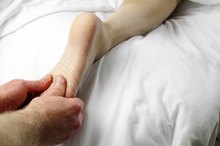Workouts for Tendonitis Leg Pain
Tendons are the tough tissue that connects your muscles to your bones and allow your limbs to move. Tendonitis occurs when the tendon becomes inflamed, usually as a result of overstretching, an impact injury or overuse. Tendonitis can occur anywhere your muscle connects to bone but is most common in the wrist, elbow, shoulder, hip, knee and heel. Fast identification and treatment of tendonitis is important to ensure you can continue with your daily activities.
Identification
Because it causes pain in and around the joints, tendonitis is often confused with arthritis. According to the American College of Rheumatology, to identify tendonitis as a cause of leg pain, your doctor will ask for a medical history, question your recent activities and perform an exam. Your doctor might order X-rays to rule out arthritis and other joint problems.
Treatment
Stretching Exercises for ACL Injuries
Learn More
Treatment for tendonitis leg pain usually includes rest to avoid aggravating the tendon, using ice packs and keeping your leg elevated to relieve swelling, and the use of elastic bandages to reduce tenderness by limiting the pull of the tendon against the bone. St. John Providence Health System notes that you can usually begin workouts after two days of treatment, or when pain from your injury lessens. Your goal is to gently stretch the tendon and build muscle around the joint.
Stretching
For tendonitis around your knee, the McKinley Health Center recommends performing a calf stretch by bracing yourself against a wall with your hands and moving one foot toward the wall. Keep your back heel on the floor and bend your front knee until you feel a stretch in the calf of your back leg. Perform a stork stretch by standing with the foot of your injured leg on a chair behind you, with your knee pointed downward. Shift your hips forward without leaning forward, feeling a stretch in your thigh muscles.
- For tendonitis around your knee, the McKinley Health Center recommends performing a calf stretch by bracing yourself against a wall with your hands and moving one foot toward the wall.
- Keep your back heel on the floor and bend your front knee until you feel a stretch in the calf of your back leg.
Strengthening
How to Keep From Locking My Knees
Learn More
To strengthen the muscles around your knee, perform a hip squat by bracing yourself against a wall and lifting your uninjured leg. Bend your injured knee as far as is comfortable, using your body weight to strengthen the muscle. Pause briefly and slowly return to a standing position. Perform a mini-squat by standing against a wall with your legs 1 to 2 feet in front of you. Slide your back down the wall, bending your knees no more than 90 degrees. Hold the position for two breaths, then return to a standing position.
- To strengthen the muscles around your knee, perform a hip squat by bracing yourself against a wall and lifting your uninjured leg.
- Slide your back down the wall, bending your knees no more than 90 degrees.
Prevention
Prevent tendonitis leg pain by stretching thoroughly and warming up before engaging in any physical activity. Use weights or resistance bands to build strength in the muscles surrounding the affected joint. Begin new exercise programs slowly, increasing duration and adding weight at a pace that does not overtax your joint, muscles or tendons. And take a break from sitting and repetitive tasks to stretch, keeping your tendons and muscles warm and flexible.
- Prevent tendonitis leg pain by stretching thoroughly and warming up before engaging in any physical activity.
- Begin new exercise programs slowly, increasing duration and adding weight at a pace that does not overtax your joint, muscles or tendons.
Warning
Do not use the injured leg until released by your doctor or physical therapist. Exercising too soon can make tendonitis worse and result in longer recovery times. Likewise, do not wait too long to gently stretch and strengthen your tendon to avoid prolonged stiffness and discomfort.
Related Articles
References
- MedlinePlus: Tendinitis (also called Tendonitis)
- American College of Rheumatology: Tendonitis
- St. John Providence Health System: The Best Ways to Treat, Prevent Tendonitis
- National Institute of Arthritis and Musculoskeletal and Skin Diseases: Bursitis and Tendinitis
- Kaux JF, Forthomme B, Goff CL, Crielaard JM, Croisier JL. Current opinions on tendinopathy. J Sports Sci Med. 2011;10(2):238-53.
- Thomopoulos S, Parks WC, Rifkin DB, Derwin KA. Mechanisms of tendon injury and repair. J Orthop Res. 2015;33(6):832-9. doi:10.1002/jor.22806
- Bubra PS, Keighley G, Rateesh S, Carmody D. Posterior tibial tendon dysfunction: an overlooked cause of foot deformity. J Family Med Prim Care. 2015;4(1):26-9. doi:10.4103/2249-4863.152245
- Davda K, Malhotra K, O'donnell P, Singh D, Cullen N. Peroneal tendon disorders. EFORT Open Rev. 2017;2(6):281-292. doi:10.1302/2058-5241.2.160047
- Simpson MR, Howard TM. Tendinopathies of the foot and ankle. Am Fam Physician. 2009;80(10):1107-14.
- Andres BM, Murrell GA. Treatment of tendinopathy: what works, what does not, and what is on the horizon. Clin Orthop Relat Res. 2008;466(7):1539-54. doi:10.1007/s11999-008-0260-1
- Houghton KM. Review for the generalist: evaluation of pediatric foot and ankle pain. Pediatr Rheumatol Online J. 2008;6:6. doi:10.1186/1546-0096-6-6
- Price GE. Rheumatology: 6. Localized rheumatism. CMAJ. 2000;163(2):176-83.
- Van den bekerom MP, Struijs PA, Blankevoort L, Welling L, Van dijk CN, Kerkhoffs GM. What is the evidence for rest, ice, compression, and elevation therapy in the treatment of ankle sprains in adults? J Athl Train. 2012;47(4):435-43. doi:10.4085/1062-6050-47.4.14
- Sterne GM, Richardson ML, Warren BH. Imaging Findings in Two Cases of Fluoroquinolone-Induced Achilles Tendinopathy. Radiol Case Rep. 2006;1(3):87-91. doi:10.2484/rcr.v1i3.32
- Li HY, Hua YH. Achilles Tendinopathy: Current Concepts about the Basic Science and Clinical Treatments. Biomed Res Int. 2016;2016:6492597. doi:10.1155/2016/6492597
- Witvrouw E, Mahieu N, Roosen P, Mcnair P. The role of stretching in tendon injuries. Br J Sports Med. 2007;41(4):224-6. doi:10.1136/bjsm.2006.034165
- Posterior Tibial Dysfunction. American Orthopaedic Foot & Ankle Society. http://orthoinfo.aaos.org/topic.cfm?topic=A00166.
- Peroneal Tendinosis. American Orthopaedic Foot & Ankle Society. http://www.aofas.org/footcaremd/conditions/ailments-of-the-ankle/Pages/Peroneal-Tendonitis.aspx.
- Achilles Tendinitis. American Academy of Orthopaedic Surgeons. http://www.orthoinfo.aaos.org/topic.cfm?topic=A00147.
- DeLee JC, et al. Tendon injuries of the foot and ankle. In: DeLee & Drez's Orthopaedic Sports Medicine: Principles and Practice. 4th ed. Philadelphia, Pa.: Saunders Elsevier; 2015.
- Scott, A.; Bachman, L.; and Speed, C. Tendinopathy: Update on pathophysiology." Journal of Orthopaedic & Sports Physical Therapy. 2015; 45(11):833-841. doi:10.2519/jospt.2015.5884
- Murtagh, B. and Ihm, J. Eccentric training for the treatment of tendinopathies. Current Sports Medicine Report. 2013; 12(3):175-181. doi:10.1249/JSR.0b013e3182933761








